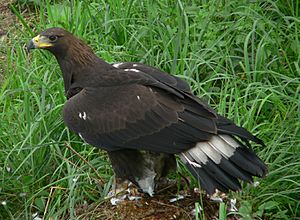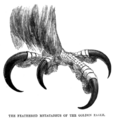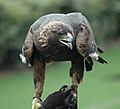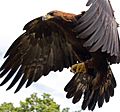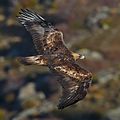Golden eagle facts for kids
Quick facts for kids Golden eagle |
|
|---|---|
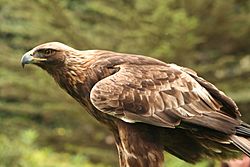 |
|
| Conservation status | |
| Scientific classification | |
| Kingdom: | |
| Class: | |
| Order: | |
| Family: | |
| Genus: |
Aquila
|
| Binomial name | |
| Aquila chrysaetos Linnaeus, 1758
|
|
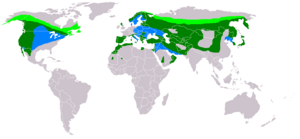 |
|
| Light green = Breeding only Blue = Wintering only Dark green = All-year |
|
The golden eagle (Aquila chrysaetos) is a very famous bird of prey. It lives in the northern hemisphere. This eagle is found in more places than any other eagle species.
Golden eagles are fast and agile hunters. They use their strong feet and sharp talons to catch animals. Their diet includes hares, rabbits, marmots, and other ground squirrels.
These amazing birds were once common across the Holarctic region. This area includes most of the northern parts of the world. However, they have disappeared from many places where lots of humans live. The golden eagle is still widespread today. It lives in Eurasia, North America, and parts of North Africa.
Like all eagles, the golden eagle belongs to the family Accipitridae. In North America, it is one of the largest birds of prey. Only the California Condor is bigger. Golden eagles also make their home in the Scottish Highlands.
Contents
About the Golden Eagle
Golden eagles come in different sizes. Some are among the largest eagles in the Aquila group. Most golden eagles are about 66 to 90 centimeters (26 to 35 inches) long. Their wings can spread from 180 to 234 centimeters (71 to 92 inches) wide. They usually weigh between 2.5 to 7 kilograms (5.5 to 15 pounds).
The smallest type of golden eagle is called A. c. japonica. The largest type is A. c. daphanea. Female golden eagles are much bigger than males. They can weigh one-quarter to one-third more than the male birds.
What They Look Like
The feathers of a golden eagle are usually black-brown to dark brown. They have a bright golden-buff color on their head and the back of their neck. This golden color glows in the sunlight, which is how the bird got its name. Their upper wings also have a lighter area that is not perfectly shaped.
Young golden eagles look similar to adults. However, their feathers are not as bright and look more patchy. They also have a white band on their tail. There is a white patch near their wing joint. These white markings slowly disappear each time the bird sheds its feathers, called a moult. They get their full adult feathers when they are about five years old.
Golden Eagle Life
What Golden Eagles Eat
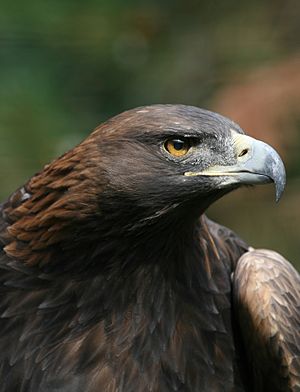
Golden eagles in North America mostly eat hares and rabbits. They also hunt squirrels, prairie dogs, and marmots. These animals make up a large part of their diet. Other mammals they eat include mice, martens, foxes, young deer, and mountain goats.
Birds are also an important food source for eagles. They often hunt game birds like pheasants, ptarmigans, and grouse. Golden eagles can hunt almost any bird, from a small jay to a large swan.
In winter, food can be hard to find. During these times, golden eagles will eat dead animals, called carrion. Sometimes, if there is no carrion, they will hunt large animals. This can include goat-antelopes and caribou.
Golden eagles have amazing eyesight. They can spot their prey from very far away. Their vision is much stronger than a human's. They use their huge talons to crush, kill, and carry their prey. Their strong beak is used for tearing and eating the food. Sometimes, a pair of eagles will hunt together. One bird might chase the prey towards its partner, who is waiting to catch it.
Reproduction
Golden eagles usually stay with the same mate for their whole lives. They build several nests, called eyries, in their territory. They use these nests one after another over many years. These nests are made of heavy tree branches. When they are in use, the eagles line them with soft grass.
The female eagle lays one to four eggs, but usually two. This happens between January and September, depending on where they live. The eggs can be all white or white with cinnamon or brown spots. The female starts sitting on the eggs right after the first one is laid. After 40 to 45 days, the young eagles hatch.
The baby eagles are covered in soft white downy feathers. Their parents feed them for about fifty days. After this time, they are ready to try their first flights and start eating on their own.
Related pages
Images for kids
-
Beinn Mhor on the Isle of Mull, Scotland is a typical home for golden eagles.
-
A close-up of a golden eagle near the Alps.
-
In Spain, golden eagles like this one in the Province of Ávila stay in one place.
-
An illustration from the 1870s showing burkut falconers in Kazakhstan.
-
In flight in the Czech Republic.
See also
 In Spanish: Águila real para niños
In Spanish: Águila real para niños



